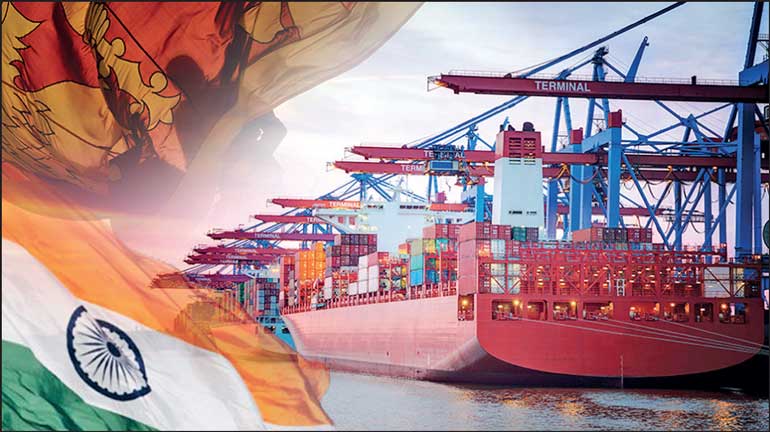Monday Apr 28, 2025
Monday Apr 28, 2025
Friday, 19 May 2023 00:05 - - {{hitsCtrl.values.hits}}

With the Sri Lankan economy showing signs of stabilising and an IMF program in place, India-Sri Lanka ties are ready to shift from an aid relationship to one which deepens bilateral trade and investment flows
 Sri Lanka is putting behind it, the dark economic days of 2022. At the time, it faced an acute balance of payments crisis, and announced a pre-emptive default on its foreign debt of over $ 50 billion in April 2022, which triggered the worst economic contraction in Sri Lanka’s post-independence history. The country’s GDP fell by -7.8% in 20221, year-on-year inflation reached 69.8% in September 2022 (measured by the Colombo Consumer Price Index)2, business confidence plummeted to an all-time low and poverty increased.
Sri Lanka is putting behind it, the dark economic days of 2022. At the time, it faced an acute balance of payments crisis, and announced a pre-emptive default on its foreign debt of over $ 50 billion in April 2022, which triggered the worst economic contraction in Sri Lanka’s post-independence history. The country’s GDP fell by -7.8% in 20221, year-on-year inflation reached 69.8% in September 2022 (measured by the Colombo Consumer Price Index)2, business confidence plummeted to an all-time low and poverty increased.
A year later, the Sri Lankan economy is showing signs of stabilising. A return to growth in Sri Lanka is expected next year. The latest IMF forecast released in April 2023 suggests a less severe economic contraction of -3.1% in 2023 and growth of 1.5% in 20243. Year-on-year inflation fell to 35.3% in April 2023 according to the Colombo Consumer Price Index4. The LMD-NielsenIQ Business Confidence Index (BCI) reported that business confidence in March 2023 is picking up slightly due to an uptick in tourism and migrant worker remittances to Sri Lanka5.
Decisive policies by the new Sri Lankan Government led by President Ranil Wickremasinghe6 and timely Indian aid helped to bring Sri Lanka back from the brink of an economic abyss. From late July 2022 onwards, the Wickremesinghe Government began implementing measures to stabilise the economy, intensified talks on an IMF program and sought assurances from Sri Lanka’s creditors on debt restructuring. Concrete economic stabilisation measures included significantly tightening monetary policy to control spiralling inflation, raising taxes, removing fuel and electricity subsidies, and developing a privatisation program for loss-making state-owned enterprises including SriLankan Airlines.
India provided the largest bilateral aid package in its history to any country. Indian aid of about $ 4 billion during the first half of 2022 flowed to Sri Lanka through credit lines, loans and grants7. India also actively pursued quiet behind the scenes diplomacy to make the case for an IMF program for Sri Lanka. The assistance began in July 2020, when, to tackle the economic fallout from the COVID-19 pandemic, the Reserve Bank of India entered into a currency swap arrangement with the Central Bank of Sri Lanka to provide short-term financing of $ 400 million. India’s aid efforts were motivated by the unfolding humanitarian crisis affecting the Sri Lankan people and political pressure from South India. Perhaps, India also felt that an unstable Sri Lankan economy could pose security risks to India and lead to a flood of refugees across the Palk Strait.
Several months after reaching a Staff-level Agreement, in March 2023 the IMF Board approved an IMF programme of $ 2.9 billion over 48 months to support Sri Lanka’s economic stabilisation efforts. The 17th and toughest IMF program in Sri Lanka’s history is a milestone towards resolving the crippling economic crisis. Focusing on revenue-based fiscal consolidation, it seeks to achieve the following six goals:
1. increase tax proceeds and increase utility prices;
2. control inflation by raising interest rates,
3. eliminating monetary financing and creating an independent Central Bank
4. rebuild reserves through a flexible exchange rate;
5. safeguard financial stability by ensuring adequately capitalised banks through the enactment of a new banking legislation; and
6. reduce corruption risks by better fiscal transparency and public financial management8.
External financing from the Asian Development Bank and the World Bank will follow the immediate disbursement of $ 333 million from the IMF program. With the Sri Lankan economy showing signs of stabilising and an IMF program in place, India-Sri Lanka ties are ready to shift from an aid relationship to one which deepens bilateral trade and investment flows. A robust Sri Lankan economy could be a major win for Prime Minister Modi’s Neighbourhood-First policy and enable India to steal a march on China as an emerging donor. Private Indian investment is starting to make a mark. Recent eye-catching investments of more than $ 1 billion by the conglomerate Adani Group in Sri Lanka are grabbing the headlines. These include: (a) $ 442 million in two renewable energy wind power plants in the Mannar basin and (b) a $ 700 million partnership between Adani, John Keells Holdings and the Sri Lanka Ports Authority to develop the West Container Terminal in Colombo Port for transshipment trade with India.
The hope, bilaterally, is that such Indian infrastructure projects will be transformative for Sri Lanka, bringing not only capital but technology and skills transfer, as also deepen local linkages with the Sri Lankan economy. The confidence built though such investments will encourage say an additional $ 5-8 billion in Indian private investment in Sri Lanka in the next few years in sectors like agro-processing, textiles and light manufacturing, and information technology services sectors.
Simultaneously, globalising Sri Lankan firms like apparel maker Brandix, tea giant Dilmah and conglomerate John Keells Holdings should invest in South Indian states in sectors like textiles, food processing and tourism. With confidence presiding well on both sides, this is the time for India and Sri Lanka to promote bilateral FDI flows by better marketing to investors, opening up FDI entry regulations and significantly streamlining the red tape hampering investment through digitisation. Early resumption of talks on a deep India-Sri Lankan trade deal to promote regional rules-based trade and investment would crown the bilateral relationship. With political will and open-door, investor friendly policies, Sri Lanka now stands a sporting chance of achieving some economic normalcy in the next three years. India’s continuing support and enhanced investments will support Sri Lanka – still fragile but moving ahead – by turning aid to business engagement.
Footnotes:
1 http://www.statistics.gov.lk.
2 https://www.cbsl.gov.lk/en/measures-of-consumer-price-inflation
3 https://www.imf.org/en/Countries/LKA
4 https://www.cbsl.gov.lk/sites/default/files/cbslweb_documents/press/pr/press_20230331_inflation_in_march_2023_ccpi_e_0.pdf
5 https://www.ft.lk/front-page/Business-confidence-picks-up-slightly/44-747025
6 https://www.gatewayhouse.in/the-reforms-sri-lanka-needs/
7 https://odi.org/en/insights/india-as-an-emerging-aid-donor-to-debt-crisis-hit-sri-lanka/
8 https://www.imf.org/en/News/Articles/2023/03/21/sp032123-sri-lanka-board-approval-of-eff-arrangement
(The writer is a Professorial Fellow in Economics and Trade, Gateway House Mumbai and Senior Research Associate ODI, London.)
Discover Kapruka, the leading online shopping platform in Sri Lanka, where you can conveniently send Gifts and Flowers to your loved ones for any event including Valentine ’s Day. Explore a wide range of popular Shopping Categories on Kapruka, including Toys, Groceries, Electronics, Birthday Cakes, Fruits, Chocolates, Flower Bouquets, Clothing, Watches, Lingerie, Gift Sets and Jewellery. Also if you’re interested in selling with Kapruka, Partner Central by Kapruka is the best solution to start with. Moreover, through Kapruka Global Shop, you can also enjoy the convenience of purchasing products from renowned platforms like Amazon and eBay and have them delivered to Sri Lanka.
Discover Kapruka, the leading online shopping platform in Sri Lanka, where you can conveniently send Gifts and Flowers to your loved ones for any event including Valentine ’s Day. Explore a wide range of popular Shopping Categories on Kapruka, including Toys, Groceries, Electronics, Birthday Cakes, Fruits, Chocolates, Flower Bouquets, Clothing, Watches, Lingerie, Gift Sets and Jewellery. Also if you’re interested in selling with Kapruka, Partner Central by Kapruka is the best solution to start with. Moreover, through Kapruka Global Shop, you can also enjoy the convenience of purchasing products from renowned platforms like Amazon and eBay and have them delivered to Sri Lanka.